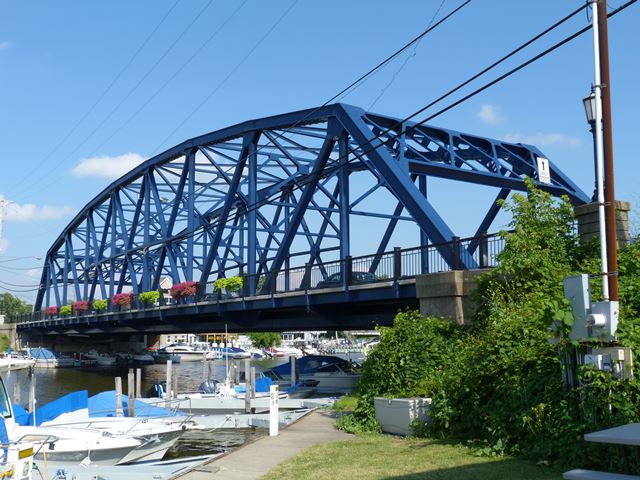We Recommend:
Bach Steel - Experts at historic truss bridge restoration.
BridgeHunter.com Phase 1 is released to the public! - Visit Now
Vermilion Bridge

Primary Photographer(s): Nathan Holth
Bridge Documented: July 7, 2014
Vermilion: Erie County, Ohio: United States
1928 By Builder/Contractor: Fort Pitt Bridge Works of Pittsburgh, Pennsylvania and Engineer/Design: Ohio State Highway Department
Not Available or Not Applicable
240.0 Feet (73.2 Meters)
246.0 Feet (75 Meters)
35 Feet (10.67 Meters)
1 Main Span(s)
2202344

View Information About HSR Ratings
Bridge Documentation
View Archived National Bridge Inventory Report - Has Additional Details and Evaluation
The Historic Bridge Inventory listed this as a Pennsylvania truss, but it is pretty clearly a Parker truss. Moreover, the Historic Bridge Inventory dismissed the bridge as not historic. However, this bridge will soon be one of the last remaining examples in the entire state of a state highway department standard-design through truss. Ohio did not have many surviving examples to begin with, yet most are slated for demolition. It is important to select some for preservation to document this period in the development of bridge design and construction in Ohio, representative of a period where truss bridges were designed by a highway department. Many states had highway departments that developed their own design of through truss and built across their respective states, either to an exact standard plan, or to custom-designed plans that still followed general parameters for design details. Each state's take on through truss design was a little different, so although state-designed trusses look alike within a particular state, when compared with other states they are all unique. As such representative examples in each state need to be considered for long-term preservation as a part of that particular state's heritage.
Currently, this particular bridge is in good condition, so it would make sense to select this one for long-term preservation and develop a management plan to that end.
Information and Findings From Ohio's Historic Bridge InventorySetting/Context The bridge carries a 2 lane highway with turning lane over the Vermilion River in Vermilion. Physical Description The 1-span, 246'-long, rivet-connected Pennsylvania thru truss bridge is composed of built-up chords and floorbeams. It was rehabilitated in 1986, which primarily consisted of replacing the deck and stringers and in-kind repairs to the truss. There is a cantilevered sidewalk with metal-panel railings. Light posts are at the bridge corners. Integrity Deck replacement (1986). Summary of Significance This is a late example of the type/design with no significant details or features. The Pennsylvania truss type/design, also sometimes referred to as a Pettit truss, is a subdivided Pratt truss with polygonal upper chord that was developed in the 1870s for use as a long-span bridge with heavy locomotives. The Pennsylvania Railroad popularized the form (hence the name), and Henry Pettit, an engineer in the employ of the railroad, became associated with it. It was not, however, used exclusively by the Pennsylvania RR being a very popular railroad and later highway truss design. Lighter pin-connected Pennsylvania truss highway bridges were built from the 1880s to 1910s, and the design also made the transition to heavier, rivet-connected designs of the mid 20th century. The truss's main advantages are an economical use of material provided by the sloped upper chord and the added stiffness provided by the substruts and ties in longer spans. Span lengths of up to 300 ft. are not uncommon. Ohio has eight identified examples dating from 1888 to 1939. Post-1900 examples are less significant than earlier examples, but they may illustrate important refinements, such as the use of riveted connections or rolled section members. Bridge Considered Historic By Survey: No |
![]()
Photo Galleries and Videos: Vermilion Bridge
Bridge Photo-Documentation
Original / Full Size PhotosA collection of overview and detail photos. This gallery offers photos in the highest available resolution and file size in a touch-friendly popup viewer.
Alternatively, Browse Without Using Viewer
![]()
Bridge Photo-Documentation
Mobile Optimized PhotosA collection of overview and detail photos. This gallery features data-friendly, fast-loading photos in a touch-friendly popup viewer.
Alternatively, Browse Without Using Viewer
![]()
Maps and Links: Vermilion Bridge
Coordinates (Latitude, Longitude):
Search For Additional Bridge Listings:
Bridgehunter.com: View listed bridges within 0.5 miles (0.8 kilometers) of this bridge.
Bridgehunter.com: View listed bridges within 10 miles (16 kilometers) of this bridge.
Additional Maps:
Google Streetview (If Available)
GeoHack (Additional Links and Coordinates)
Apple Maps (Via DuckDuckGo Search)
Apple Maps (Apple devices only)
Android: Open Location In Your Map or GPS App
Flickr Gallery (Find Nearby Photos)
Wikimedia Commons (Find Nearby Photos)
Directions Via Sygic For Android
Directions Via Sygic For iOS and Android Dolphin Browser
USGS National Map (United States Only)
Historical USGS Topo Maps (United States Only)
Historic Aerials (United States Only)
CalTopo Maps (United States Only)

